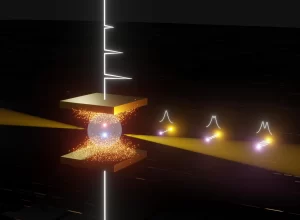Quantum Interplay | Uniting Light and Matter in Pure Form | A Journey Through the Simplest Geometric Framework of Quantum Coupling
 Researchers have made a significant advance in the field of nanophotonics and optoelectronics by demonstrating strong light-matter coupling using a simplified structure. This structure consists of a single-layer transition-metal dichalcogenide (TMD), specifically tungsten disulfide, placed on a silver film. This approach bypasses the traditional requirement of enclosing the material in a microcavity, which, while enhancing coupling strength, adds to the complexity of fabrication and can obstruct further manipulation of the TMD.
Researchers have made a significant advance in the field of nanophotonics and optoelectronics by demonstrating strong light-matter coupling using a simplified structure. This structure consists of a single-layer transition-metal dichalcogenide (TMD), specifically tungsten disulfide, placed on a silver film. This approach bypasses the traditional requirement of enclosing the material in a microcavity, which, while enhancing coupling strength, adds to the complexity of fabrication and can obstruct further manipulation of the TMD.
The team at Humboldt University of Berlin, led by Nicolas Zorn Morales, utilized a vapor-deposition method to grow large-area, high-quality monolayers of TMD, which were then transferred to the silver film. They employed total internal reflection ellipsometry (TIRE) to measure light-matter coupling in their samples. This technique, which is sensitive to phase changes upon light reflection, allowed them to clearly differentiate between strong and weak coupling regimes.
Their findings showed a significant “mixing” of light and matter energy levels, with a measured coupling strength of 26 meV. Although this value is about half of what is achieved with microcavity-based devices, it still falls within the strong-coupling regime. The researchers believe that their tunable and less complex devices could pave the way for the development of new plasmonic modulators, switches, and sensors.
Key Takeaways:
- A single-layer transition-metal dichalcogenide (TMD) on a silver film can achieve strong light-matter coupling without complex structures like microcavities.
- The research team used total internal reflection ellipsometry to measure significant coupling strength between light and matter in their large-area monolayer TMD samples.
- This simpler method of achieving strong light-matter coupling offers a new avenue for developing plasmonic devices such as modulators, switches, and sensors.
“Structures that exhibit strong light–matter coupling can change their optical properties under illumination, offering many potential applications in nanophotonics and optoelectronics.”
More details: here

Leave a Reply